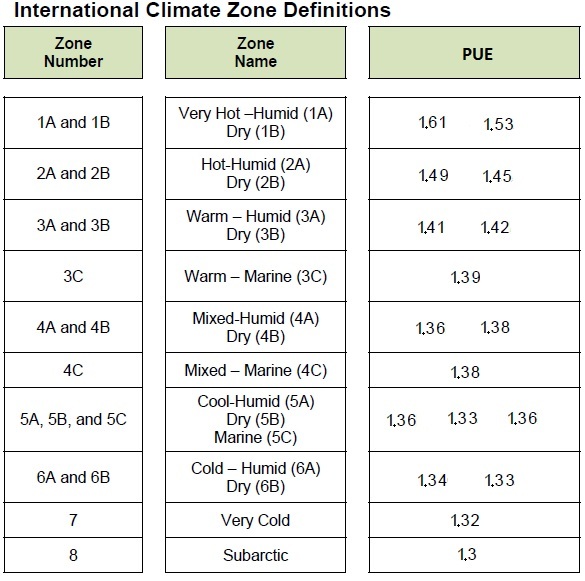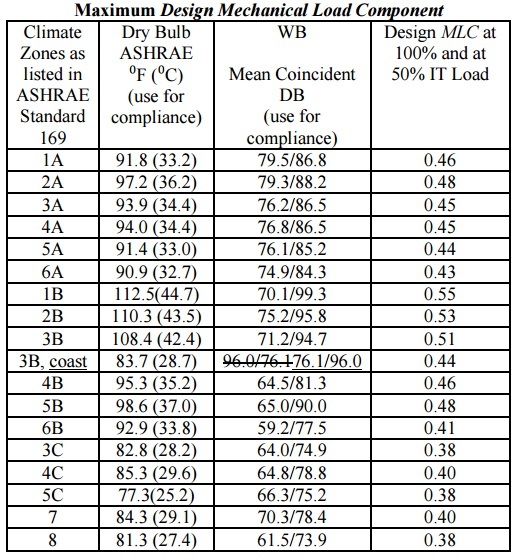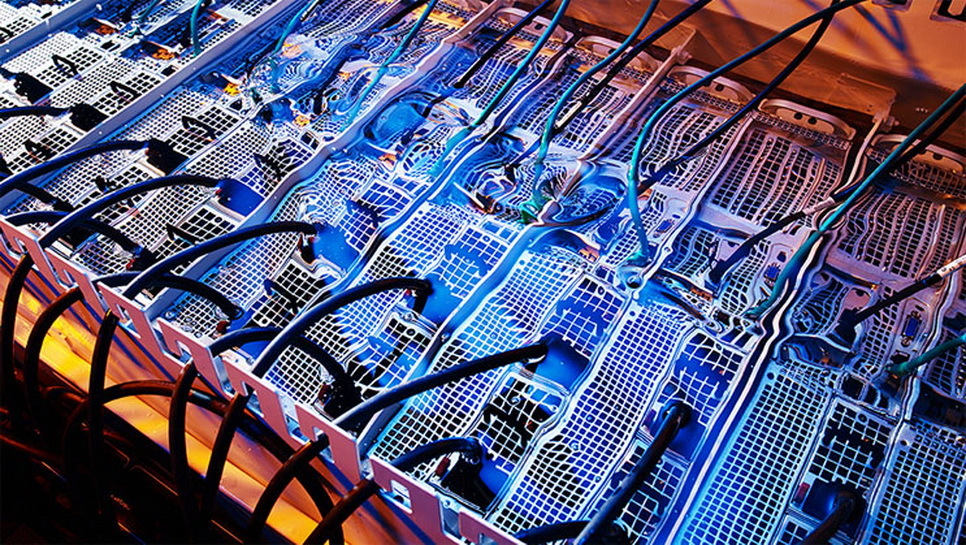PUE celebrates its 10th anniversary. What a sad gift has the IT community prepared for him?
This reserved abbreviation PUE (Power Usage Effectiveness) has become widely known not only among a narrow circle of specialists - data center designers, but also among such a wide audience as consumers of services provided by these same data centers. For the first time, PUE, a coefficient characterizing the energy efficiency of a data center (Data Processing Center), was introduced back in 2006. He was offered to use the non-profit organization Green Grid, which was created from IT industry specialists. Over the ten years of its existence, the coefficient has served not only as a measure of the efficiency of the IT infrastructure, but also the cause of many disputes about the correctness of its application, as well as the need to develop a more up-to-date algorithm for assessing the energy efficiency of data centers. It is worth remembering how, in pursuit of the “moment of glory”, marketers of provider companies launched advertising campaigns, using the frankly weak points of the coefficient, quite subtly quoting the above-mentioned criterion, wishing or not, brought to the absurdity the very existence of this insidious PUE .
Will the anniversary year of 2016 actually become the last for the existence of a coefficient that is so usual, very simple and understandable to use, which has generated a huge number of discussions, and if so, what will replace it? In these and some other issues related to the energy efficiency of data centers, we will try to understand this article.

')
Why consumers of services often pay attention to the energy efficiency of the building in which they plan to place their server platform, a rack or simply to rent a single server is not difficult to explain. After all, starting cooperation with the data center, we all want to deal with an efficient and modern infrastructure, which is one of the guarantees of its cloudless operation. The most affordable price of services, not as a result of poor quality of services or dumping, but as a result of lower costs for maintaining the site’s performance, a significantly lower risk will unexpectedly be confronted with a large-scale reconstruction of the data center in pursuit of a reduction in the energy loss of the facility and an increase in its competitiveness in the market. And of course, the status of a “green data center” that uses the resources of the Earth with the utmost care also plays an important role, especially for consumers of services from countries with high standards of living. With regards to the owners of the data center - it's still more obvious. Electricity is the most costly resource necessary for the functioning of a large data center and the more efficiently this resource is used, the more competitive the supply of IT infrastructure on the market will be.

Calls to abandon the use of PUE as a universal measure, sounded for a long time. But they all broke up about the reality of the absence of a more or less adequate alternative to it. However, this could not be forever. The American Association of Heat and Power Engineers, known by the acronym ASHRAE, in its latest update of energy efficiency standards 90.4 (published in early 2016) decided to finally abandon the use of PUE, replacing it with its new MLC (Mechanical Load Component). When did this process begin and why did it lead to such results?
Just over a year ago, in January 2015, in the first edition of energy efficiency standards 90.4, prepared by ASHRAE specialists, it was already possible to see the first hints of future changes in the approach to assessing the performance of the data center.

As you can see from the above data, the main message of innovation was the desire of the compilers to isolate from the overall picture of energy consumption for data center equipment, the costs directly for its cooling component. By means of the gradation of PUE values for different climatic zones, it became possible to more correctly determine whether the data center under consideration is energy efficient. The focus was on the qualitative characteristics of the functioning of the heat exchange system, in the construction being evaluable.
For the first time, the abbreviation MLC appeared already in the second (August) version of the energy efficiency standards for buildings and equipment 90.4. In this update, the concept of MLC was introduced in parallel with the familiar PUE. In this version of the editorial board, the drafters went even further in developing their idea to factor out of the general level of energy consumption of IT equipment, the level of consumption of the conditioning system. This was the root cause of the introduction of MLC and the subsequent refusal of ASHRAE specialists from the usual PUE.

As it can be seen in the presented formula, the MLC coefficient will always dial values less than one, trying to achieve its minimum values, provided that the server equipment is cooled as efficiently as possible. After all, the total power consumption of energy of all components of the cooling system will be significantly less compared with the consumption of electricity by the data center as a whole.

According to one of the developers of standards 90.4 Clark Bergerson:
Apparently, for the aforementioned reasons, ASHRAE specialists decided to focus all their attention on the potential for upgrading the heat sink in data centers.

At first glance, the very approach to localizing attention on the heat exchange system in the data center is quite rational and has the right to life. By the simplicity of the calculations, the MLC just proposed is also not inferior to the good old PUE, and its simplicity, as we know, was one of the main arguments of the PUE supporters. The only thing that the usual PUE surpasses the newcomer of the MLC is, perhaps, in the "promotion". However, over time, it is MLC that has all chances to become the main measure of energy efficiency of data centers, a cause of pride for designers and one of the important factors when choosing services from clients of hosting companies.
Will the anniversary year of 2016 actually become the last for the existence of a coefficient that is so usual, very simple and understandable to use, which has generated a huge number of discussions, and if so, what will replace it? In these and some other issues related to the energy efficiency of data centers, we will try to understand this article.

')
Why consumers of services often pay attention to the energy efficiency of the building in which they plan to place their server platform, a rack or simply to rent a single server is not difficult to explain. After all, starting cooperation with the data center, we all want to deal with an efficient and modern infrastructure, which is one of the guarantees of its cloudless operation. The most affordable price of services, not as a result of poor quality of services or dumping, but as a result of lower costs for maintaining the site’s performance, a significantly lower risk will unexpectedly be confronted with a large-scale reconstruction of the data center in pursuit of a reduction in the energy loss of the facility and an increase in its competitiveness in the market. And of course, the status of a “green data center” that uses the resources of the Earth with the utmost care also plays an important role, especially for consumers of services from countries with high standards of living. With regards to the owners of the data center - it's still more obvious. Electricity is the most costly resource necessary for the functioning of a large data center and the more efficiently this resource is used, the more competitive the supply of IT infrastructure on the market will be.

Calls to abandon the use of PUE as a universal measure, sounded for a long time. But they all broke up about the reality of the absence of a more or less adequate alternative to it. However, this could not be forever. The American Association of Heat and Power Engineers, known by the acronym ASHRAE, in its latest update of energy efficiency standards 90.4 (published in early 2016) decided to finally abandon the use of PUE, replacing it with its new MLC (Mechanical Load Component). When did this process begin and why did it lead to such results?
Just over a year ago, in January 2015, in the first edition of energy efficiency standards 90.4, prepared by ASHRAE specialists, it was already possible to see the first hints of future changes in the approach to assessing the performance of the data center.

As you can see from the above data, the main message of innovation was the desire of the compilers to isolate from the overall picture of energy consumption for data center equipment, the costs directly for its cooling component. By means of the gradation of PUE values for different climatic zones, it became possible to more correctly determine whether the data center under consideration is energy efficient. The focus was on the qualitative characteristics of the functioning of the heat exchange system, in the construction being evaluable.
For the first time, the abbreviation MLC appeared already in the second (August) version of the energy efficiency standards for buildings and equipment 90.4. In this update, the concept of MLC was introduced in parallel with the familiar PUE. In this version of the editorial board, the drafters went even further in developing their idea to factor out of the general level of energy consumption of IT equipment, the level of consumption of the conditioning system. This was the root cause of the introduction of MLC and the subsequent refusal of ASHRAE specialists from the usual PUE.

As it can be seen in the presented formula, the MLC coefficient will always dial values less than one, trying to achieve its minimum values, provided that the server equipment is cooled as efficiently as possible. After all, the total power consumption of energy of all components of the cooling system will be significantly less compared with the consumption of electricity by the data center as a whole.

According to one of the developers of standards 90.4 Clark Bergerson:
Comparing the two coefficients, the imperfection of PUE becomes immediately clear. In fact, a high level of PUE was achieved not due to the low electrical consumption of the heat sink composite data center, but due to the savings on “lighting bulbs” and the large dimensions of the structure. Considering that the main consumer of electricians in the data center has always been server hardware and its cooling system, it wasn’t at all possible to compare data centers that were different in terms of server equipment. Even with identical design solutions of two data centers, the ratio of energy consumption of IT equipment to the consumption of the entire structure will always be more “energy efficient” for that IT complex, which is greater.
By accepting the condition that all modern server equipment existing on the market is as close as possible to its energy consumption characteristics, it becomes obvious that it’s not obvious that it is possible to increase the efficiency of the data center through server components. That of course you can’t say about heat transfer systems.
Apparently, for the aforementioned reasons, ASHRAE specialists decided to focus all their attention on the potential for upgrading the heat sink in data centers.

At first glance, the very approach to localizing attention on the heat exchange system in the data center is quite rational and has the right to life. By the simplicity of the calculations, the MLC just proposed is also not inferior to the good old PUE, and its simplicity, as we know, was one of the main arguments of the PUE supporters. The only thing that the usual PUE surpasses the newcomer of the MLC is, perhaps, in the "promotion". However, over time, it is MLC that has all chances to become the main measure of energy efficiency of data centers, a cause of pride for designers and one of the important factors when choosing services from clients of hosting companies.
Source: https://habr.com/ru/post/279053/
All Articles